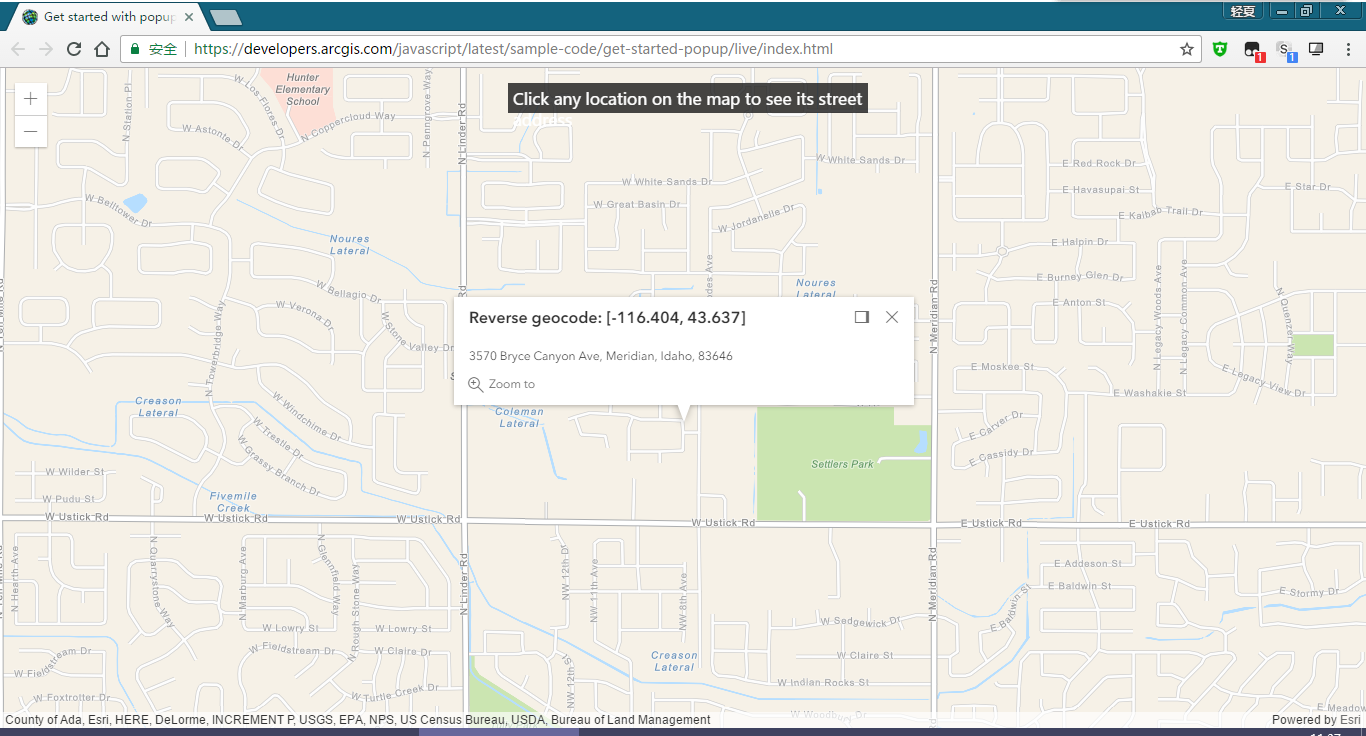看本文前最好对第二章(Mapping and Views)中的Map和View类有理解。
视图类有一个属性是Popup类型的popup,查阅API知道这个就是视图的弹窗,每一个View的实例都有一个popup。
这个popup属性在View对象实例化的时候就实例化了的,即随着View的出生,它也会出生,它拥有默认的样子,它显示的文字也是默认的样式。
我们看看Popup这个类:

直接继承自Accessor,位于widgets模块下,说明Popup(弹窗)也是小部件的一种。但是为什么要单独拿出来讲呢?可能用法上比较复杂吧。
如果用户对弹窗有更高的样式要求,官方的说法是
可以自己new一个Popup对象,替换掉view默认的popup即可。
其实Popup有个兄弟类,叫PopupTemplate,它长得很像Popup,但是在功能上更服务于Layer和Graphic,即地理数据,而且也是高度可自定义的,在下一节会细说这两个的区别。
说完了Popup这个新玩意儿,我就来说说第一个例子吧!
它的功能就是点击View上的一个地方,就会弹出一个小窗,显示经纬度和其他信息。
引用
直接给:
require( [ "esri/tasks/Locator", "esri/Map", "esri/views/MapView", "dojo/domReady!" ], function(){} );
函数参数中因为Map和View 对象是经常性出现的,所以就用 var map = new Map(...);代替了(以后也是)
所以函数参数的关键代码是:
function(Locator, Map, MapView){ var map = new Map(...); var view = new MapView(...); var locatorTask = new Locator({ url : "https://geocode.arcgis.com/arcgis/rest/services/World/GeocodeServer";
}); view.on("click", funcion(event){...}) }
locatorTask是一个Locator类的对象,用于定位服务。这个不用知道太详细,因为本例中重点并不是它。
重点应该是view的事件“click”,写法同上,但是事件的方法体没有写完整。
我们就来看看这个事件的方法体具体是什么:
function(event){ //获取经纬度 var lat = Math.round(event.mapPoint.latitude * 1000) / 1000; var lon = Math.round(event.mapPoint.longitude * 1000) / 1000; view.popup.open({ title: "Reverse geocode: [" + lon + ", " + lat + "]", location: event.mapPoint }); //定位服务,可以省略,不是本例中的主要内容 locatorTask.locationToAddress(event.mapPoint) .then(function(response) { var address = response.address.Match_addr; view.popup.content = address; }) .otherwise(function(err) { view.popup.content = "No address was found for this location"; }); }
我们看到了,从click事件的event参数中获取到了lat和lon,即经纬度,用Math.round方法对数字进行了一定的处理。
然后关键的一句:
view.popup.open({...});
我们先不说这个是什么,但是肯定是一个方法。
下面的then()方法,是Locator对象的locationToAddress方法的Promise返回对象的回调,用于获取地址成功后把地址显示到popup上。
关键的一句:
view.popup.content = address;
在下面otherwise()方法也有类似的。
现在,我们转到Popup这个类的定义。
Popup类
继承自Accessor类
主要属性:actions(Collection类型)、content(String或Node类型)、location(Point类型)、title(String类型)...
主要方法:open()、destroy()...
看得出,上面的代码使用了open方法,content属性、location属性、title属性。
open方法会把popup的visible属性改为true,然后显示到指定的位置:location。
是不是很简单呢?
更深一层的理解,既然能open,那么肯定是有这个实例的,更说明了popup这个属性是一个对象,在View实例化的时候就完成了实例化。
对其content、title属性进行设置就可以在弹出窗中看到想要的内容和标题了。
总结一下。
1. View对象自带Popup实例,并随着View对象实例化而实例化。
2. Popup使用open()方法显示出来,接受location、title、content等可选参数以指定内容、弹窗点等。
最后给个图:

很显而易见。
给出官方的源代码(没有删除注释)

<!DOCTYPE html> <html> <head> <meta charset="utf-8"> <meta name="viewport" content="initial-scale=1,maximum-scale=1,user-scalable=no"> <title>Get started with popups - 4.2</title> <style> html, body, #viewDiv { padding: 0; margin: 0; height: 100%; width: 100%; } #instruction { z-index: 99; position: absolute; top: 15px; left: 50%; padding: 5px; margin-left: -175px; height: 20px; width: 350px; background: rgba(25, 25, 25, 0.8); color: white; } </style> <link rel="stylesheet" href="https://js.arcgis.com/4.2/esri/css/main.css"> <script src="https://js.arcgis.com/4.2/"></script> <script> require([ "esri/tasks/Locator", "esri/Map", "esri/views/MapView", "dojo/domReady!" ], function( Locator, Map, MapView ) { // Set up a locator task using the world geocoding service var locatorTask = new Locator({ url: "https://geocode.arcgis.com/arcgis/rest/services/World/GeocodeServer" }); // Create the Map var map = new Map({ basemap: "streets-navigation-vector" }); // Create the MapView var view = new MapView({ container: "viewDiv", map: map, center: [-116.3031, 43.6088], zoom: 12 }); /******************************************************************* * This click event sets generic content on the popup not tied to * a layer, graphic, or popupTemplate. The location of the point is * used as input to a reverse geocode method and the resulting * address is printed to the popup content. *******************************************************************/ view.on("click", function(event) { // Get the coordinates of the click on the view var lat = Math.round(event.mapPoint.latitude * 1000) / 1000; var lon = Math.round(event.mapPoint.longitude * 1000) / 1000; view.popup.open({ // Set the popup's title to the coordinates of the location title: "Reverse geocode: [" + lon + ", " + lat + "]", location: event.mapPoint // Set the location of the popup to the clicked location }); // Display the popup // Execute a reverse geocode using the clicked location locatorTask.locationToAddress(event.mapPoint).then(function( response) { // If an address is successfully found, print it to the popup's content var address = response.address.Match_addr; view.popup.content = address; }).otherwise(function(err) { // If the promise fails and no result is found, print a generic message // to the popup's content view.popup.content = "No address was found for this location"; }); }); }); </script> </head> <body> <div id="viewDiv"></div> <div id="instruction">Click any location on the map to see its street address</div> </body> </html>
